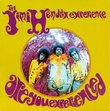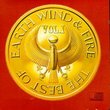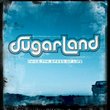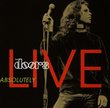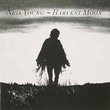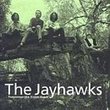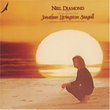| All Artists: Grateful Dead Title: Aoxomoxoa Members Wishing: 8 Total Copies: 0 Label: Rhino / Wea Original Release Date: 1/1/1969 Re-Release Date: 2/25/2003 Album Type: Original recording reissued, Original recording remastered Genres: Pop, Rock, Classic Rock Styles: Jam Bands, Rock Jam Bands, Psychedelic Rock Number of Discs: 1 SwapaCD Credits: 1 UPCs: 081227439422, 081227439460 |
Search - Grateful Dead :: Aoxomoxoa
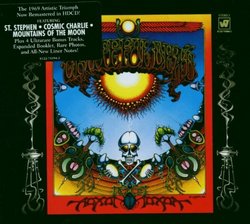 | Grateful Dead Aoxomoxoa Genres: Pop, Rock, Classic Rock
Expanded & remastered (HDCD) version of the band's 1969 album, packed with 4 bonus rarities 'Clementine Jam', 'Nobody's Spoonful Jam', 'The Eleven Jam' & 'Cosmic Charlie' (live). Digipak. Warner/Rhino. 2003. |
Larger Image |
CD DetailsSynopsis
Album Description Expanded & remastered (HDCD) version of the band's 1969 album, packed with 4 bonus rarities 'Clementine Jam', 'Nobody's Spoonful Jam', 'The Eleven Jam' & 'Cosmic Charlie' (live). Digipak. Warner/Rhino. 2003. Similarly Requested CDs
|
CD Reviews"Aoxomoxoa" Louie Bourland | Garden Grove CA | 02/19/2004 (4 out of 5 stars) "The Grateful Dead's third studio album "Aoxomoxoa" serves as a bridging gap between the band's psychedelic experiments and the harmony-laced folk-rock they would adopt a few years later. The album still remains a favorite amongst Deadheads and includes concert staples such as "Saint Stephen", "China Cat Sunflower" and "Cosmic Charlie". There are also some fun sing-along moments such as the memorable "Dupree's Diamond Blues" and "Doin' That Rag". "Rosemary" and "Mountains of the Moon" are beautiful acoustic pieces that fuse folk and baroque influences into the mix. Then, there's the infamous "What's Become Of The Baby" which is nothing but 8-minutes worth of Jerry Garcia chanting with vast amounts of echo plastered on his voice. Depending on who you talk to, this track is either the Dead's finest studio moment or their absolute worst. Either way, the track certainly is different. The Rhino/Warner remaster includes four additional tracks which brings this album to more than double of its original length. The first three bonus tracks are extended instrumental jams recorded live in the studio. Like always, the band's musicianship and ability to play off each other comes through effortlessly in these jams. There is a definite jazz-fusion feel to these improvisations. "The Eleven Jam" is particularly striking with it's use of odd time signatures (mostly 11/8). The bonus material closes with a rare live recording of "Cosmic Charlie" which is a bit raw and rough but solid. Since it's initial release 35 years ago "Aoxomoxoa" has become an instant Dead classic. With its diverse range of styles (everything from standard rock, to avant-garde, to acoustic and now with the bonus tracks, improvisation and jazz), "Aoxomoxoa" remains a highly entertaining album. On a technical and historical note, this album was also the very first in history to be recorded using 16-track technology which is the reason for its sharp pristine sound. From here, The Grateful Dead's Long Strange Trip only got better." An underrated masterpiece of oddness rambleon | ann arbor, mi | 06/21/2004 (5 out of 5 stars) "though "blues for allah" is probably the most accurate studio representation of what the dead truly were and are, "aoxomoxoa" is still my favorite dead record. it was recorded right when the band was making the natural transistion from bluesy psychedelic music and into a more folkish country sound. you can really hear the two musical realms butt heads. even the simple folk songs like "rosemary" and "mountains of the moon" have a real ambient psychedelic mood to them. however, "what's become of the baby" is definitely the oddest track on the album and is almost too spooky to listen to. dead naysayers who claim that the band wasn't dark and were only into singing about good times have obviously never heard this track. the album also includes the future concert staples "china cat sunflower" and "st. stephen," but a really good track that the band all but abondanded not too long after the record's release is "doin' that rag." it's got a lot of great effects and time changes and really sounds like the musical equivalent to going insane. this record really captures a great transistional period in the band's history and will grow on you immensely after repeated listenings. the remastered version also has some great studio jams, including the only studio recording of the phenomenal live favorite "the eleven." one more great reason to buy this thing immediately" Original, 3 stars; remastered, 4 stars happydogpotatohead | New Orleans, LA USA | 12/30/2005 (4 out of 5 stars) "A transitional album for the Dead, in between the wilder psychedelic years and the return to roots music that followed. Strong songwriting and playing and good production make this one of the Dead's more successful studio albums. However, as usual, the live versions of all of these songs should be heard as well. Much of the Dead's studio work serves as a template for what the songs turned into live. That said, this is a fine album, with the exception of "What's Become of the Baby," which quite honestly could have been left off the album entirely and few would have cared.
This CD features the 1972 "remix" of the album, as every Deadhead knows. The reason for this is because no one could find the original mix of Aoxomoxoa, according to interviews with Dead archivist David LeMieux. Rhino, in conjunction with the Dead, decided that it would be better to release a strong version of the 1972 mix. The alternative would have been to release a straight album-to-CD digital transfer with inferior sound. The included extra material, to my mind, more than makes up for the lack of the original mix. The studio jams and outtakes add a lot to this album and show that the Dead were powerful musicians, something that often gets overlooked outside the circle of Deadheads. Overall, this remaster is worth having, especially for those who aren't Deadheads per se but want to get a grip on what the Dead were all about." |

 Track Listings (12) - Disc #1
Track Listings (12) - Disc #1